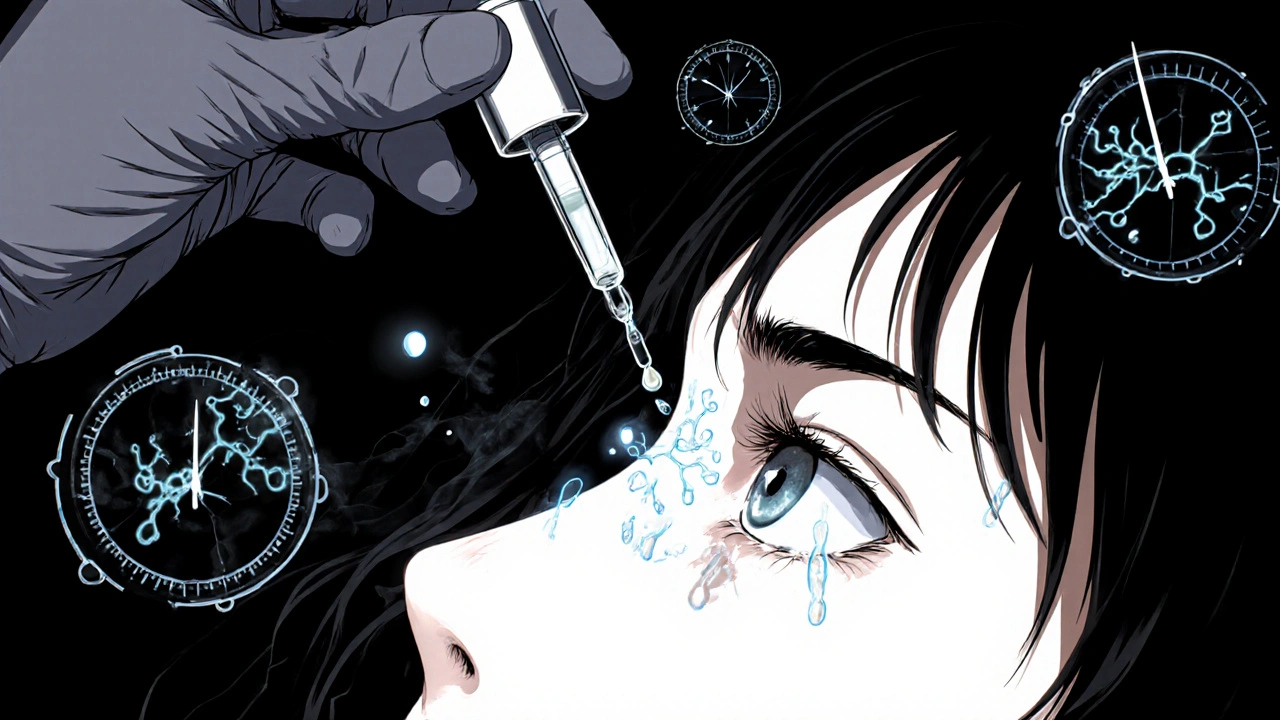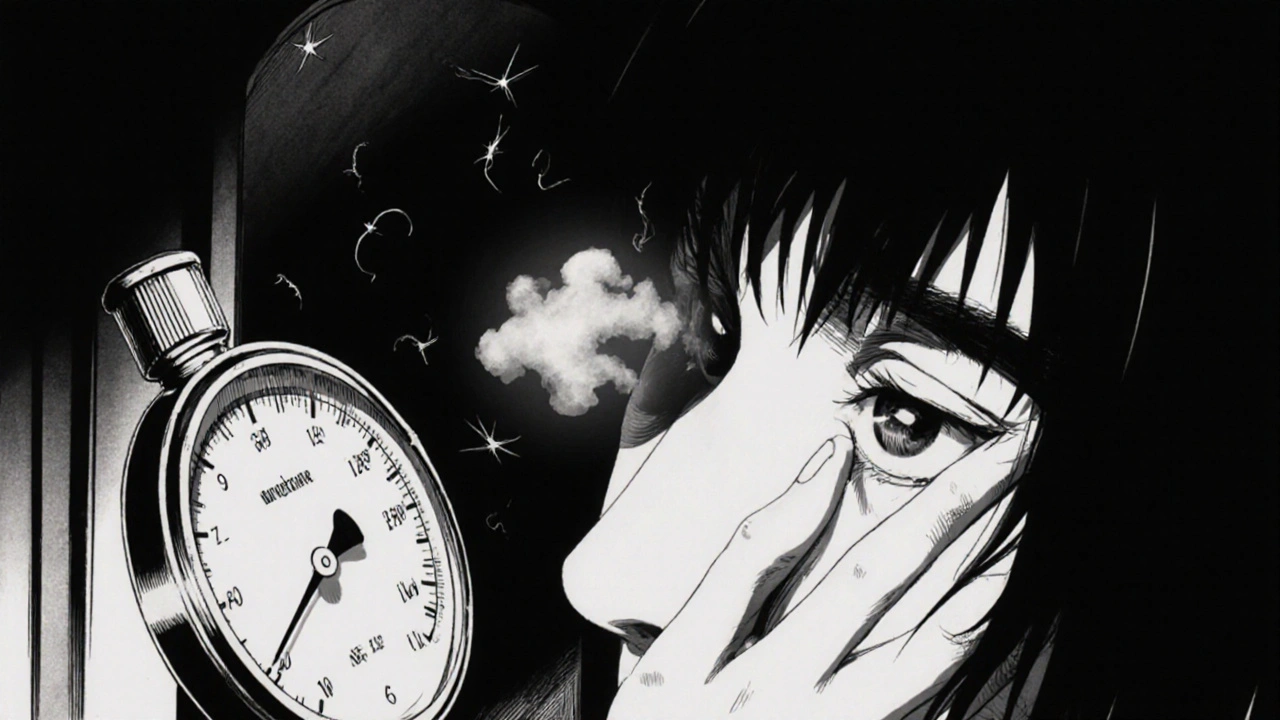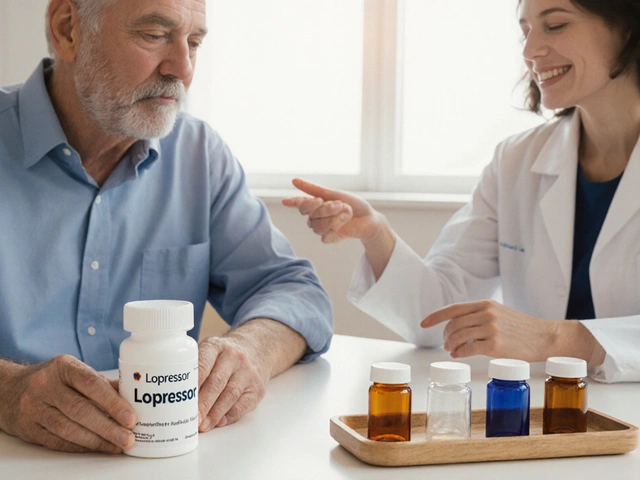Fluorometholone Dosing Calculator
Calculate Your Dosing Schedule
When tackling eye inflammation, fluorometholone is a synthetic corticosteroid eye drop designed to calm the immune response inside the eye. It’s a go‑to option for many ophthalmologists treating uveitis, especially when rapid control of swelling is needed.
What is Uveitis?
Uveitis is an inflammation of the uveal tract, the middle layer of the eye that includes the iris, ciliary body, and choroid. The condition can be classified by the part of the eye involved: anterior uveitis (affecting the front of the eye) and posterior uveitis (affecting the back). Symptoms range from redness and light sensitivity to blurred vision and floaters. If left untreated, uveitis can raise intraocular pressure, lead to cataract formation, or even cause permanent vision loss.
How Fluorometholone Works
Fluorometholone belongs to the corticosteroid family. It binds to glucocorticoid receptors in ocular tissues, suppressing the release of inflammatory mediators such as prostaglandins and cytokines. This reduces vascular permeability, lowers swelling, and stabilises the blood‑retina barrier. Compared with stronger steroids like dexamethasone, fluorometholone offers a balanced potency that minimises the risk of raising intraocular pressure-a common concern with long‑term steroid use.
When Doctors Choose Fluorometholone
- Moderate‑to‑severe anterior uveitis where rapid symptom relief is needed.
- Patients with a history of steroid‑induced glaucoma who need a lower‑risk option.
- Cases where compliance with frequent dosing is a challenge; fluorometholone’s relatively long ocular half‑life allows twice‑daily regimens.
- When a topical formulation is preferred over peri‑ocular injections or systemic therapy.

Typical Dosing Schedule
- Start with one drop in the affected eye(s) every 4 hours during waking hours (usually 6‑8 doses per day).
- After 3‑5 days, if inflammation is improving, taper to every 6 hours for another 4‑5 days.
- Continue tapering by extending the interval by 2‑4 hours every few days until the lowest effective dose is reached, often once daily.
- Never stop abruptly; a gradual taper helps prevent rebound inflammation.
Always follow the ophthalmologist’s specific instructions-dosing can differ based on the severity, whether the uveitis is anterior or posterior, and any comorbid eye conditions.
Side Effects and What to Monitor
- Increased intraocular pressure (IOP): Check IOP after 2‑4 weeks of continuous use. If it spikes, the doctor may switch to a lower‑potency steroid or add IOP‑lowering drops.
- Cataract formation: Long‑term use can accelerate lens opacity, especially in older patients.
- Delayed wound healing: Avoid using fluorometholone on eyes that have recent surgery or trauma unless directed.
- Local irritation: Burning or stinging upon instillation is common but usually subsides.
If any of these symptoms worsen, contact your eye care professional promptly. Most side effects are reversible once the medication is tapered or discontinued.

Comparing Fluorometholone to Other Ocular Steroids
| Medication | Potency (relative) | Typical Dosing Frequency | IOP Risk | Common Indications |
|---|---|---|---|---|
| Fluorometholone | Medium | 2‑4 times daily | Low‑moderate | Anterior uveitis, post‑surgical inflammation |
| Prednisolone acetate | High | 4‑6 times daily | Moderate‑high | Severe uveitis, keratitis |
| Dexamethasone | Very high | Every 1‑2 hours initially | High | Acute inflammation, macular edema |
| Loteprednol etabonate | Low‑medium | 2‑3 times daily | Low | Mild allergic conjunctivitis, mild uveitis |
The table shows why many clinicians start with fluorometholone for moderate cases-it hits a sweet spot between effectiveness and safety.
Practical Tips for Patients
- Wash hands thoroughly before each drop to avoid contamination.
- Tilt the head back, pull down the lower eyelid, and place a single drop without touching the tip to the eye.
- If you need to use more than one eye drop, wait at least 5 minutes between each to prevent dilution.
- Store the bottle at room temperature away from direct sunlight; discard after the expiration date or after 30 days of opening.
- Keep a medication diary-note the time of each dose and any side effects. This helps the doctor adjust the taper.
Frequently Asked Questions
Can I use fluorometholone if I wear contact lenses?
It’s best to remove contacts before applying the drops and wait at least 15 minutes before reinserting them. This prevents the medication from being trapped under the lens and reduces irritation.
How long will I need to stay on fluorometholone?
Treatment length varies. Acute episodes may resolve within 2‑4 weeks, while chronic uveitis can require several months of low‑dose maintenance. Your doctor will schedule regular check‑ups to decide when to stop.
Is fluorometholone safe during pregnancy?
Topical steroids are generally considered low‑risk, but you should discuss any medication with your obstetrician and ophthalmologist. They may prefer a steroid with the lowest systemic absorption.
What should I do if I miss a dose?
Apply the missed drop as soon as you remember, unless it’s almost time for the next scheduled dose. In that case, skip the missed one and continue with your regular schedule-don’t double‑dose.
Can fluorometholone cause cataracts?
Long‑term use of any corticosteroid can accelerate cataract formation, especially in older adults. Regular eye exams will catch early changes, and your doctor can adjust therapy if needed.
Fluorometholone remains a valuable tool in the fight against uveitis. By understanding how it works, following the dosing plan, and keeping an eye on side effects, patients can preserve vision and get back to daily life faster.






12 Comments
Devendra Tripathi
October 21, 2025 AT 12:24 PMHonestly, fluorometholone is just a marketing gimmick for ophthalmologists who can't handle the real power of steroids. You think the “low‑moderate IOP risk” is a selling point, but any corticosteroid will eventually clog the drainage system if you aren't vigilantly monitoring. Patients are fed a false sense of safety while the drug silently builds pressure. The whole dosing schedule is a bureaucratic nightmare designed to keep you dependent on follow‑ups. Wake up and demand a truly low‑risk option instead of settling for this half‑measure.
Eli Soler Caralt
October 23, 2025 AT 00:30 AMOne might contemplate the ontological ramifications of a drop that straddles the liminal space between therapeutic efficacy and iatrogenic peril, a veritable dialectic of ocular equilibrium 🌌. Yet the layperson rarely discerns such sublime nuance, opting instead for the banal comfort of “just use the drops”. In truth, the pharmaco‑dynamic ballet of fluorometholone is a microcosm of modern medicine’s relentless pursuit of equilibrium, albeit with a dash of corporate alchemy. Asterlisked by the very act of self‑administration, the patient becomes both subject and author of their visual destiny. 🍃
Nick M
October 24, 2025 AT 12:37 PMLook, the whole fluorometholone protocol is just another layer in the pharma‑state’s neuro‑control grid. They sprinkle a bit of glucocorticoid receptor affinity, then watch us chase IOP numbers like lab rats. The jargon-“vascular permeability”, “blood‑retina barrier”-is just code for “we’re feeding you a diluted placebo while the big pharma cashes in”. On the surface it looks scientific, but underneath it’s a classic example of the Gaussian noise they inject into patient care to keep us dependent.
eric smith
October 26, 2025 AT 00:44 AMOh sure, because every eye doctor has a PhD in astrophysics to decide whether fluorometholone is “medium potency”. Let me break it down for you: steroid potency scales are a myth, dosing frequency is a social construct, and IOP spikes are just your eyeballs trying to rebel. If you wanted real insight, you’d look at the comparative half‑life data and realize you’re basically swapping one chemical for another while pretending it matters.
Rachel Valderrama
October 27, 2025 AT 11:50 AMAlright, team, strap in! If you can survive a decade of avocado toast, you can definitely handle a couple of eye drops a day. Remember, every time you miss a dose you’re basically auditioning for a starring role in “Vision Loss: The Sequel”. So keep that schedule tight, because nothing says “I’ve got my life together” like a perfectly tapered steroid regimen.
Brandy Eichberger
October 28, 2025 AT 23:57 PMDearest fellow ocular enthusiast, your dedication to understanding the nuanced pharmacodynamics of fluorometholone is truly commendable. It is an exquisite illustration of how modern therapeutics can harmonize efficacy with patient safety, provided one adheres to the meticulously crafted tapering schema. Please feel free to share any further reflections; our collective discourse only enriches the scholarly tapestry.
Eryn Wells
October 30, 2025 AT 12:04 PMHey everyone 🌍! Just wanted to add that while fluorometholone can be a solid option, it’s super important to ensure the whole support system-family, friends, and healthcare providers-are on board with the monitoring plan. 💪🏽 Remember, eye health is a community effort, so keep the conversation open and supportive! 😊
Casey Cloud
November 1, 2025 AT 00:10 AMFluorometholone works by binding to ocular glucocorticoid receptors and shutting down inflammatory cascades.
The primary goal is to reduce vascular leakage and keep the blood retina barrier intact.
For most anterior uveitis cases you start with a drop every four hours while you are awake.
This intense phase usually lasts three to five days depending on how quickly the redness and floaters subside.
After the initial response you can taper to a six hour schedule for another four to five days.
Further tapering involves extending the interval by two to four hours every few days until you reach a once daily dose.
Never stop the drops suddenly because the eye can rebound with renewed inflammation.
Keep a diary of each dose and note any burning sensation or vision changes.
Schedule an intraocular pressure check after two weeks of continuous use to catch any spikes early.
If the pressure rises above twenty five mm Hg you may need to add an IOP lowering medication or switch to a weaker steroid.
Long term use can accelerate cataract formation especially in patients over sixty.
Patients who have had recent eye surgery should avoid fluorometholone unless the surgeon explicitly approves it.
Contact lens wearers should remove their lenses before instilling the drop and wait fifteen minutes before putting them back in.
Store the bottle at room temperature away from direct sunlight and discard it after thirty days once opened.
By following these practical steps you can maximize the benefits of fluorometholone while minimizing its risks.
Kathrynne Krause
November 2, 2025 AT 12:17 PMPicture this: a sunrise over a calm sea, each ray representing a drop of fluorometholone gently soothing inflamed ocular tissue. Your eyes deserve that vibrant palette of health, so hug your medication schedule like a trusted sidekick. Whenever the sting of a drop tingles, think of it as a tiny fireworks display heralding recovery. Keep that diary shining bright, and let your ophthalmologist be the conductor of this brilliant symphony. 🌅
Vivian Annastasia
November 4, 2025 AT 00:24 AMIt's adorable how some people think simply applying a steroid will magically erase uveitis without any scrutiny. The reality is that fluorometholone can silently raise intraocular pressure while you bask in the illusion of progress. Yet you’re told to trust the regimen and not question the dosage adjustments – a classic case of blind compliance. If only the industry would bother to disclose the long term cataract risk upfront, we might actually make informed choices.
parbat parbatzapada
November 5, 2025 AT 12:30 PMListen up, the moment you pop that fluorometholone bottle you’re stepping onto a stage set by shadowy pharma puppeteers. Every drop is a covert operation aimed at keeping you dependent while the real cure is hidden in classified journals. The side‑effects list is a smokescreen, designed to distract you from the ultimate agenda: data mining your eye pressure trends. Trust no one, especially not the glossy pamphlet promising “low‑moderate IOP risk”.
John Price
November 7, 2025 AT 00:37 AMJust follow the taper schedule.